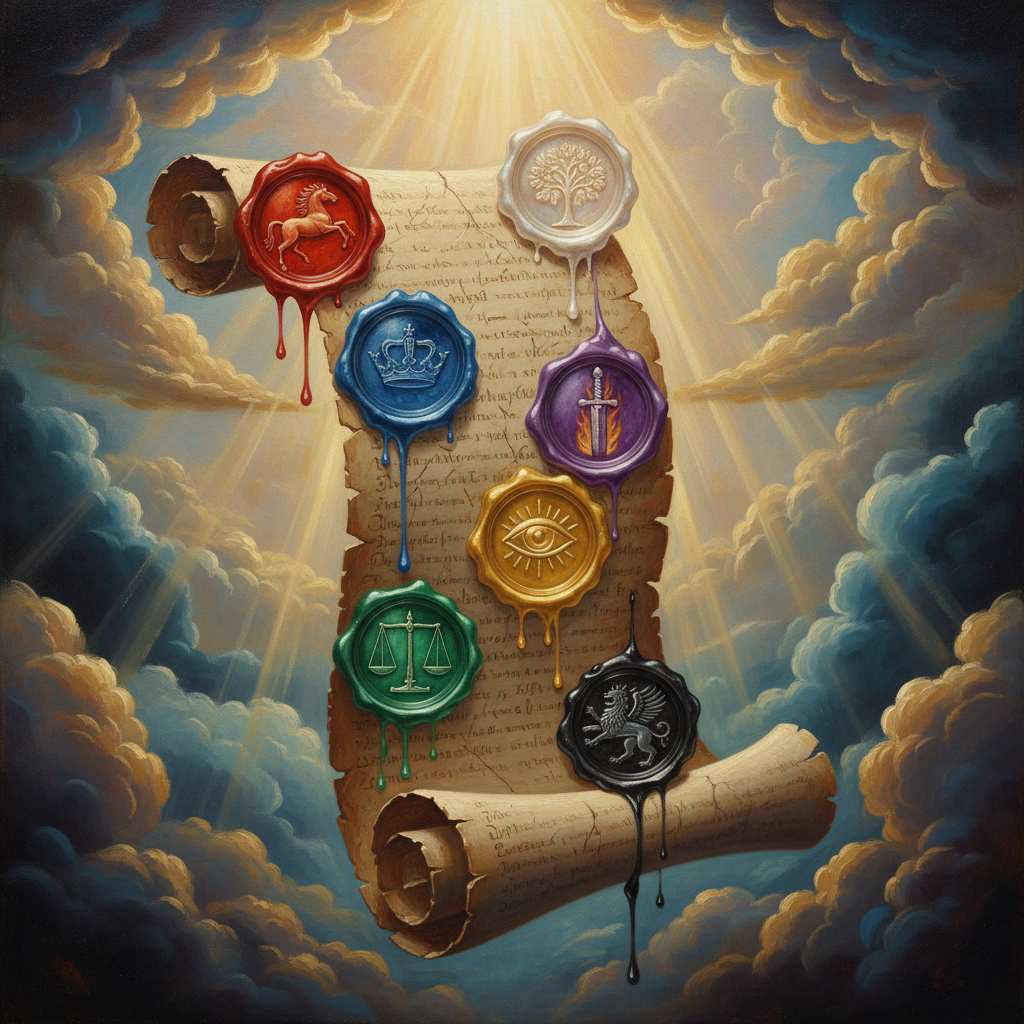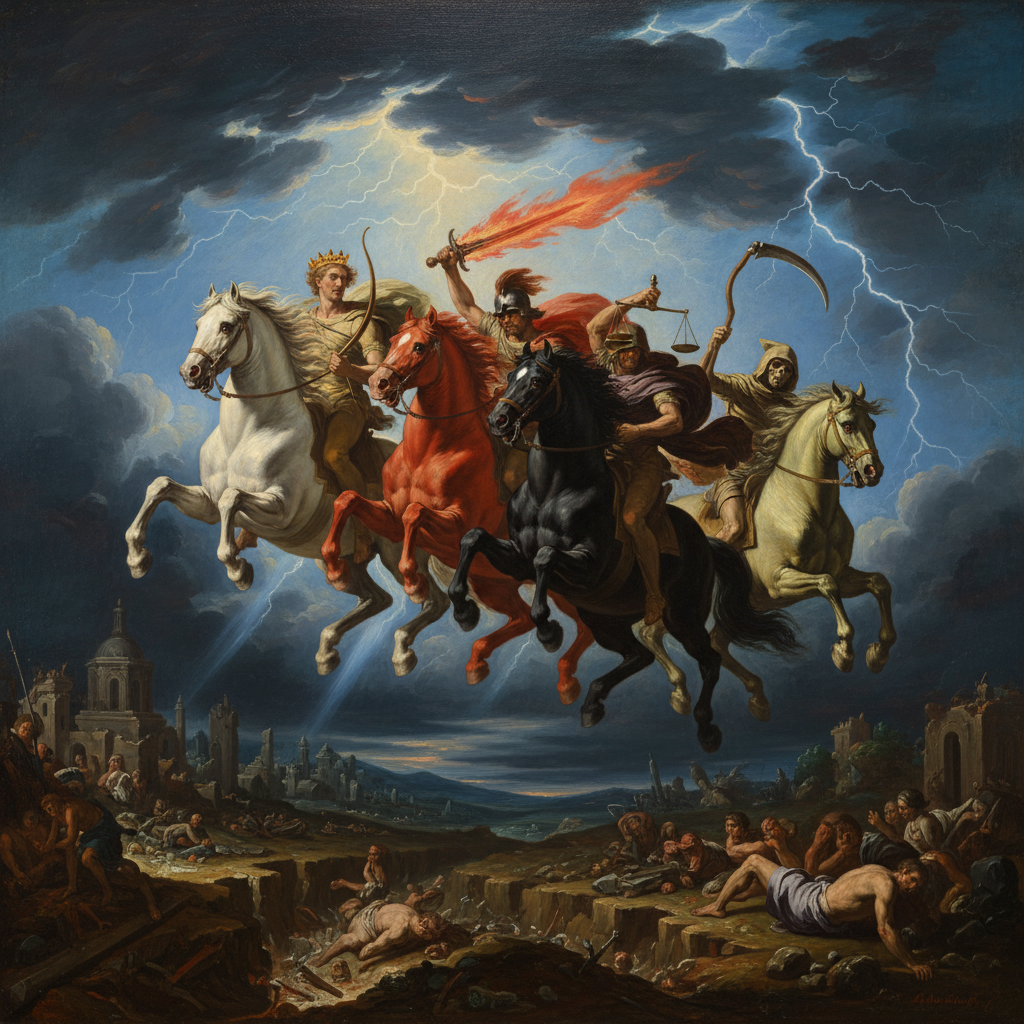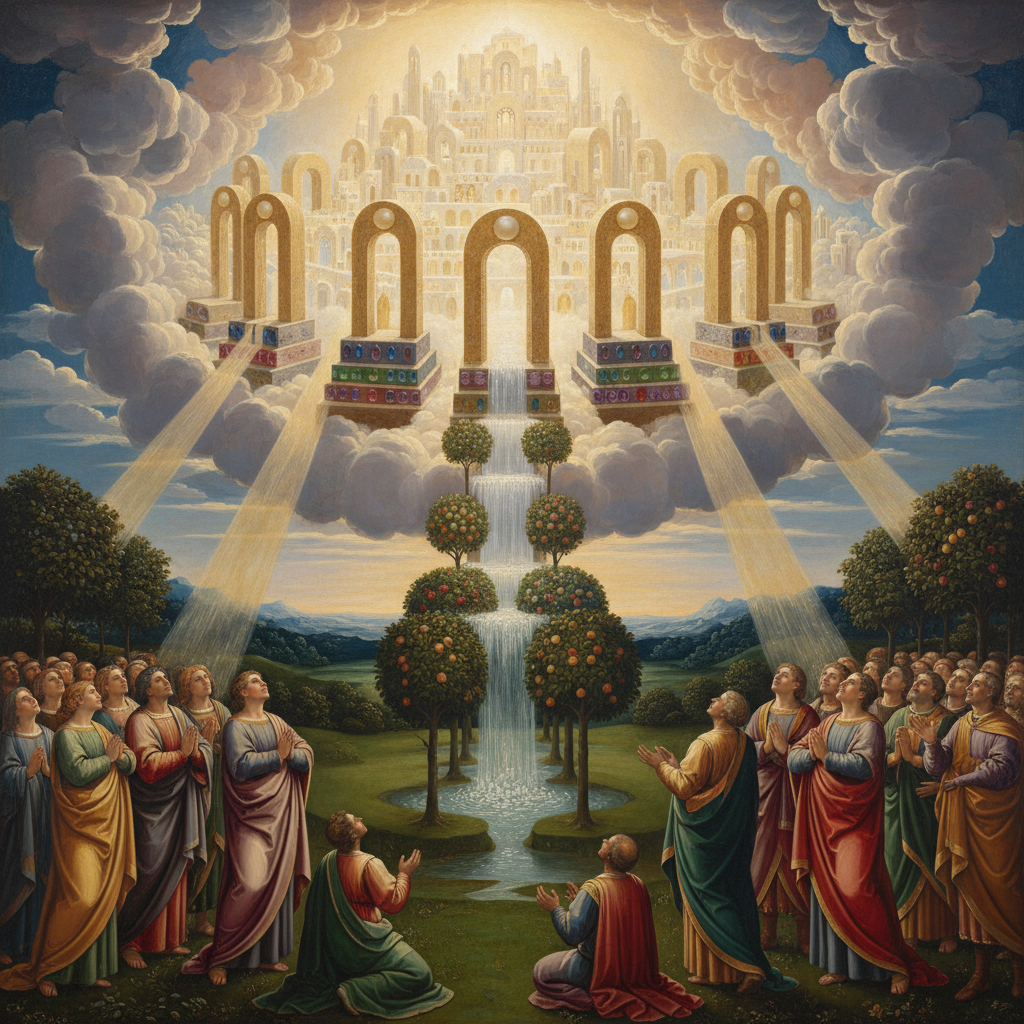Picture this: An elderly man stands on a rocky island in the Aegean Sea, squinting against the Mediterranean sun. Around him, nothing but scrub brush, wind-carved stone, and the endless blue horizon. This is Patmos, a Roman penal colony, and the man is John - the last living apostle of Jesus Christ. He's in his nineties now, exiled here by Emperor Domitian for refusing to worship Caesar as a god.
It's Sunday morning, around 95 AD. The small Christian communities scattered across Asia Minor - Ephesus, Smyrna, Pergamum, Thyatira, Sardis, Philadelphia, Laodicea - are gathering in secret house churches. They're facing brutal persecution. Some have already been martyred. Others have watched their businesses collapse because they won't participate in trade guild ceremonies honoring false gods. Their families are ostracized. Their children are mocked. And every day, the pressure mounts: just burn a pinch of incense to Caesar's statue, say "Caesar is Lord," and all this suffering stops.
That's when John hears a voice behind him, loud as a trumpet. He turns and sees seven golden lampstands. Among them stands someone "like a son of man" - but this is no ordinary man. His eyes blaze like fire. His voice sounds like rushing water. His face shines like the sun at full strength. John, who once leaned against Jesus' chest at the Last Supper, falls at his feet like a dead man. What John sees next, and writes down in what we call the Book of Revelation, has fascinated, terrified, and confused readers for nearly 2,000 years.

The Mystery of Revelation's Authorship and Purpose
The author identifies himself simply as "John, your brother and companion in the suffering and kingdom and patient endurance that are ours in Jesus" (Revelation 1:9). Early church fathers unanimously identified this John as the apostle, the son of Zebedee, the beloved disciple. By the end of the first century, John was the only apostle still alive. Peter and Paul had been executed under Nero. James, John's brother, was the first apostle martyred. John alone remained - a living link to Jesus himself.
The dating matters. Most scholars place Revelation's writing around 95-96 AD, during the reign of Emperor Domitian. This emperor, paranoid and megalomaniacal, demanded to be addressed as "Dominus et Deus" - Lord and God. He commissioned statues of himself across the empire and required periodic demonstrations of loyalty through emperor worship. For Christians whose core confession was "Jesus is Lord," this created an impossible situation. Comply and deny Christ. Refuse and face economic ruin, social ostracism, or death.
This is the crucible in which Revelation was forged. It's not a roadmap for future geopolitical events or a coded prediction about microchips and global currencies. It's resistance literature. It's a pastoral letter written to seven real churches facing real persecution, telling them: Hold on. Don't give up. Don't compromise. God is still in control. The beast that seems invincible right now - Rome - will fall. The Lamb who was slain is the one who truly reigns. Your suffering has meaning. Victory is certain.
Understanding this historical context transforms how we read Revelation. Suddenly, "Babylon the Great" isn't a future geopolitical entity but Rome, drunk on the blood of martyrs. The beast with the fatal wound that healed isn't a future antichrist but the Roman Empire itself, which survived Nero's suicide and civil war. The pressure to receive the beast's mark isn't about future technology but the immediate choice Christians faced: participate in Rome's idolatrous economic system or be shut out of commerce entirely.
Understanding Apocalyptic Literature: It's Not What You Think
Here's where most readers get Revelation wrong from the start: they read it as if it were straightforward prophecy, a literal timeline of future events. But Revelation belongs to a specific literary genre called apocalyptic literature, and if you don't understand the genre, you'll misinterpret the message.
Apocalyptic literature was Judaism's political cartoon, its underground resistance poetry, its coded language for discussing politics and theology when open discussion meant death. Think of it like wartime propaganda posters or underground samizdat literature in the Soviet Union. The images are vivid, bizarre, symbolic. A beast with seven heads? That's not a biological prediction. It's political commentary. The number 666? Not a barcode or microchip. It's code for Nero Caesar, the first great persecutor.
Jewish apocalyptic writing flourished from roughly 200 BC to 200 AD, and it followed recognizable patterns. There's always a heavenly mediator (an angel) showing the seer visions. The imagery is borrowed from Israel's prophetic tradition - Daniel, Ezekiel, Isaiah, Zechariah. Time is described in symbolic periods (three and a half years, forty-two months, 1,260 days - all the same period). Numbers carry meaning beyond their mathematical value. Colors matter. Animals represent political powers. Cosmic disruptions symbolize earthly upheavals.
When Revelation describes stars falling from the sky or the moon turning to blood, first-century readers steeped in Jewish prophetic tradition would immediately think of Isaiah and Joel, where similar language described historical events like the fall of Babylon or the destruction of Jerusalem. This is symbolic language for political upheaval, not a literal astronomy lesson.
The genius of apocalyptic literature is plausible deniability. If Roman authorities seized John's scroll, they might recognize it as subversive but couldn't quite prove sedition. Christian readers, however, fluent in biblical imagery, would get it immediately. The seven-headed beast? That's Rome with its seven hills and succession of emperors. The harlot city? Rome again, the empire that seduced nations with its wealth and power while persecuting God's people. This wasn't prediction of a distant future. It was commentary on their present suffering and God's promise of vindication.

Decoding Revelation's Symbolism: A Field Guide
Let's crack the code. Once you understand the symbolic language, Revelation stops being a puzzle and starts being a powerful message of hope. Here are the major symbols and what they actually mean.
The Number Seven: Divine Perfection
Seven appears more than fifty times in Revelation. Seven churches. Seven spirits. Seven seals. Seven trumpets. Seven bowls. Seven thunders. In Jewish numerology, seven represented completeness and perfection, rooted in God's seven-day creation. When Revelation uses seven, it's emphasizing God's complete sovereign control. The seven churches aren't just seven random congregations - they represent the whole church throughout time. The seven seals, trumpets, and bowls don't necessarily describe sequential events but complete judgment from every angle.
The Number 666: Human Failure Tripled
This is probably the most famous number in the Bible, and countless theories have identified it with everyone from Nero to Napoleon to various modern politicians. But understanding ancient gematria (where letters have numerical values) helps. In Hebrew, "Nero Caesar" adds up to 666. In Latin, "Divi Filius" (son of god, Caesar's title) equals 666. But there's a simpler interpretation: six is one short of seven. It's the number of humanity created on the sixth day. Triple sixes represent humanity's repeated failure to achieve divine perfection, no matter how many times it tries.
The mark of the beast on right hand or forehead isn't a future implant. It's a parody of Deuteronomy 6:8, where Israelites were told to bind God's law on their hands and foreheads. The mark represents total allegiance - what you do (hand) and what you think (forehead). In John's day, this meant participating in emperor worship and Rome's economic system. For every generation since, it's the same fundamental choice: will you compromise your faith for economic advantage? Will you worship the beast (whatever form it takes) or the Lamb?
The Four Horsemen: Conquest, War, Famine, Death
When the first four seals are opened, four horsemen ride out. White horse (conquest), red horse (war), black horse (famine), pale horse (death). These aren't future apocalyptic events. They're the recurring pattern of human history, especially in the Roman world John knew. Conquest breeds war. War brings famine. Famine leads to death. This is the human condition under fallen powers. Yet even as these horsemen ride, they're constrained by God's permission. They can only do what the Lamb allows when he opens the seals. Even in judgment, sovereignty remains with Christ.
The Seven Seals, Trumpets, and Bowls: Recapitulation, Not Sequence
Many readers assume these three judgment series are chronological - first the seals, then the trumpets, then the bowls. But notice the parallels. All three series include judgments affecting earth, sea, fresh water, and celestial bodies. All three culminate in earthquake and hail. Rather than sequential events, these are likely the same reality described three times from different angles, each intensifying in severity.
The seals represent initial birth pains. The trumpets are warning blasts, destroying one-third (partial judgment calling people to repent). The bowls are complete wrath, poured out without mixture. This recapitulation - telling the same story multiple times with increasing detail and intensity - is common in apocalyptic literature. Think of it like watching a storm approach: first you see distant clouds, then you hear thunder, then the rain hits. Same storm, three perspectives.

The Two Beasts: Political and Religious Power
Revelation 13 introduces two beasts. The first rises from the sea (a symbol of chaos and gentile nations), has seven heads and ten horns, and receives worship from the whole world. The second rises from the earth, has two horns like a lamb but speaks like a dragon, and enforces worship of the first beast. This is John's coded description of Rome's political power (the first beast) and the imperial cult enforcing emperor worship (the second beast, the false prophet).
But the pattern transcends first-century Rome. Throughout history, political power has partnered with religious or ideological systems to demand total allegiance. Nazi Germany. Soviet Communism. Any totalitarian system that makes ultimate claims on human loyalty. The details change. The fundamental choice remains constant: will you bow to the beast or remain faithful to the Lamb, even if it costs everything?
Babylon the Great: The Seductive System
In chapters 17-18, John sees a vision of a great harlot named "Babylon the Great," drunk on the blood of martyrs, sitting on seven hills, ruling over the kings of earth. This is clearly Rome - the city on seven hills whose wealth and power seduced nations while persecuting Christians. But "Babylon" carries Old Testament baggage too. Babylon destroyed Jerusalem and exiled God's people. In prophetic literature, Babylon represents the world system opposed to God - seductive, wealthy, powerful, but ultimately doomed.
When Revelation declares "Fallen, fallen is Babylon the great!" it's announcing the certain demise of every system that opposes God, demands worship, and persecutes believers. Rome fell. Other empires have fallen since. All earthly powers rise and fall. Only God's kingdom endures. That's the point. Don't be seduced by Babylon's wealth. Don't fear her power. She's already fallen. The verdict is announced even before the execution.
Four Ways to Read Revelation: Which View Is Right?
If you've studied Revelation before, you've probably encountered fierce debates about interpretation. Good people who love Jesus and believe the Bible disagree vehemently about what Revelation means. Understanding the four major interpretive frameworks helps you navigate these debates with humility and wisdom.
The Preterist View: It's Already Happened
Preterists (from the Latin "praeteritus," meaning "gone by") argue that most or all of Revelation was fulfilled in the first century, particularly in the destruction of Jerusalem (AD 70) and the fall of Rome. The beast is Nero or the line of Roman emperors. The tribulation is the persecution under Nero and Domitian. The great battle at Armageddon is the Jewish War. The thousand-year reign is the church age.
Strengths: This view takes seriously Revelation's historical context and John's pastoral intent to encourage his original audience facing immediate persecution. It avoids wild speculation about microchips and European trade agreements. It explains why Jesus said these things would "soon take place" (Revelation 1:1).
Weaknesses: Some passages seem to describe events clearly still future - like the final resurrection, new heavens and earth, and Christ's visible return. Full preterism can struggle to explain these.
The Historicist View: It's Church History Unfolding
Historicists see Revelation as a symbolic outline of church history from the first century to Christ's return. The seven churches represent seven periods of church history. The various judgments correspond to historical events like the barbarian invasions, the rise of Islam, the Protestant Reformation, and so forth. This view was popular among Reformers who saw the papal system as the antichrist.
Strengths: This view sees Revelation as relevant to every generation of church history, not just the first century or the final generation. It emphasizes God's sovereignty over all human history.
Weaknesses: Historicist interpretations are notoriously subjective. Every generation identifies different historical events with Revelation's symbols. The method tends toward allegorizing without clear controls. It's also quite Western-centric, assuming European church history is the focus.
The Futurist View: It's Still Coming
Futurists argue that chapters 4-22 primarily describe events still future to us - a seven-year tribulation, the rise of a literal antichrist, a rebuilt Jewish temple, a rapture of the church, a millennium reign of Christ on earth, and the final judgment. This view dominates American evangelical Christianity and spawns countless end-times prophecy books and movies.
Strengths: This view takes literally the descriptions of Christ's return, resurrection, judgment, and new creation. It maintains a sense of expectancy and hope for Christ's coming. It explains the vivid language as actual future events rather than symbolic descriptions of past or ongoing realities.
Weaknesses: This view can disconnect Revelation from its first-century context and original readers. If chapters 4-22 are entirely about the future, what comfort did they offer churches facing immediate persecution in AD 95? It also tends toward speculation, reading current events into ancient prophecy in ways that prove embarrassing when predictions fail.
The Idealist View: It's Timeless Truth
Idealists (or spiritualists) see Revelation as symbolic literature presenting timeless spiritual truths about the ongoing battle between good and evil, God and Satan, the church and the world. Rather than describing specific historical events or future predictions, Revelation portrays principles that apply to every generation. The beast represents all totalitarian powers throughout history. Babylon is every seductive worldly system. The message is always relevant.
Strengths: This view keeps Revelation relevant to every generation without the need to identify specific historical fulfillments or future predictions. It focuses on practical application and spiritual truth rather than prophetic charts. It avoids the embarrassment of failed predictions.
Weaknesses: If Revelation is purely symbolic and timeless, it can become so generic as to mean everything and nothing. It may undervalue the book's actual predictions about Christ's return, final judgment, and new creation. It can make Revelation less specific and therefore less comforting than John intended.
So Which View Is Right?
Here's the thing: elements of all four views contain truth. Revelation was immediately relevant to first-century churches (preterist insight). It has spoken to Christians throughout church history (historicist insight). It does describe the actual future return of Christ and final judgment (futurist insight). And its principles apply to every generation facing persecution and compromise (idealist insight).
Most biblical scholars today embrace some form of "eclectic" interpretation, combining elements from multiple views. Revelation was written to specific churches in specific circumstances, but with principles that transcend those circumstances. It describes both historical events John's readers would recognize and ultimate realities still to come. The key is holding these perspectives in tension rather than rigidly committing to one framework that excludes all others.
Why Revelation Terrifies and Fascinates
No other book of the Bible provokes such extreme reactions. Some Christians avoid Revelation entirely, finding it too confusing, too scary, or too prone to misuse by date-setters and conspiracy theorists. Others become obsessed with it, spending countless hours on elaborate prophetic charts correlating current events with perceived biblical predictions.
The fear is understandable. Revelation contains graphic imagery: a dragon devouring a newborn child, locusts with human faces and scorpion tails, blood flowing as high as horses' bridles, people crying out for mountains to fall on them. The judgments are severe. The destruction is total. It's vivid, violent, and visceral.
But here's what fear misses: Revelation isn't horror literature designed to scare you. It's encouragement literature designed to strengthen you. The original readers were terrified already - not of future judgment but of present persecution. They were watching their friends martyred. They were losing their businesses. Their children were suffering. And the Roman Empire looked invincible.
Revelation pulls back the curtain to show them reality: Rome isn't sovereign. Caesar isn't Lord. That empire that looks so permanent is already judged, already fallen. The Lamb who appears weak - slain, bleeding - is actually on the throne running the show. The martyrs haven't lost. They've won. They're wearing white robes, singing victory songs, safe in God's presence while their persecutors face judgment.
The fascination is equally understandable. Revelation addresses humanity's deepest questions: Is there meaning to history? Does justice exist? Will evil win? What happens after death? How does it all end? These aren't trivial curiosities. They're existential necessities. And Revelation answers with resounding clarity: History is going somewhere. Justice is certain. Evil loses. Death is defeated. Christ returns and makes all things new.
The tragedy is when fascination becomes speculation, when people spend more time arguing about the timing of the rapture than living faithfully in light of Christ's return, when Revelation becomes an excuse for escapism ("it's all going to burn anyway") rather than a call to faithful presence. John didn't write Revelation so we could create prophetic flowcharts. He wrote it so we'd worship Jesus, resist idolatry, endure persecution, and live hopefully as we await the coming kingdom.

Stories from People Who Studied Revelation
Understanding Revelation changes people. Here are real stories from Bible Way users who worked through this challenging book.
Michael, a businessman from Texas, avoided Revelation for thirty years. "I grew up hearing Revelation preached as a scary countdown to Armageddon," he says. "All the talk about 666 and the antichrist and the mark of the beast just freaked me out. I figured I'd leave it to prophecy experts." Then his adult daughter, a seminary student, challenged him to study it with her. "She showed me the historical context - that John was writing to encourage persecuted Christians, not scare future Americans. That changed everything. Now Revelation is one of my favorite books. It's all about Jesus winning. How did I miss that for so long?"
Sarah, a pastor in Philadelphia, describes teaching Revelation as a turning point in her ministry. "Our church had gone through a rough season - conflict, division, feeling like we were failing. I almost avoided Revelation because I thought it would be too confusing for people already struggling. But I decided to trust that John wrote this as encouragement, not confusion." She taught through all 22 chapters over six months. "People started seeing themselves in those seven churches - especially Sardis, the dead church, and Philadelphia, the faithful church with little strength. The message that Jesus wins, that our present struggles matter but don't define the outcome, that we're called to faithful endurance, not success - it transformed our congregation."
David, a theology professor, spent years studying Revelation academically before it became personal. "I could explain preterism, futurism, all the scholarly debates. I'd written papers on symbolic interpretation. But it was abstract, intellectual." Then he was diagnosed with cancer. "Suddenly the martyrs' cry 'How long, O Lord?' wasn't academic. It was my cry. Reading Revelation while going through chemotherapy, I got it. This isn't a puzzle to solve. It's a promise to cling to. The new Jerusalem with no more death, mourning, crying, or pain - that's not symbolic. That's hope. That's where this story ends."
Jennifer grew up in a tradition that read Revelation as a detailed roadmap of future events. "We had charts showing exactly how the end times would unfold - the rapture, the tribulation, the antichrist, all of it. And every few years, someone would come up with a new date or a new candidate for the antichrist. It was exhausting." In college, she took a class on apocalyptic literature. "Learning about the genre, the historical context, the symbolic nature of the imagery - it was liberating. I could still believe Christ is coming back without needing to decode newspaper headlines. Revelation became encouraging instead of anxiety-inducing."
Marcus, a missionary in Southeast Asia, sees Revelation with fresh eyes in a context of real persecution. "Western Christians debate millennium views. Christians here face a choice: participate in mandatory ancestral worship or lose your business license. The mark of the beast isn't future technology. It's present reality. Revelation speaks directly to our situation. The promise that the beast's reign is temporary, that the martyrs win, that patient endurance has meaning - we need that message. It's life-giving."
Common Misconceptions Cleared Up
Let's address some of the most widespread misunderstandings about Revelation head-on.
Misconception 1: Revelation Is Mostly About the Future
Truth: Revelation is primarily about encouraging first-century Christians facing persecution, though it also describes Christ's ultimate return and final judgment. The book opens by saying "what must soon take place" (1:1) and declares "the time is near" (1:3). John wrote to seven specific churches with specific problems. Yes, Revelation describes the second coming and new creation (events still future to us). But most of the book addresses the immediate situation of churches facing Rome's persecution. If we make Revelation entirely about our future, we miss its original message and pastoral purpose.
Misconception 2: The Point Is to Figure Out Exactly When Christ Returns
Truth: Jesus explicitly said "no one knows the day or hour" (Matthew 24:36). Every generation that's tried to calculate the date has been wrong - spectacularly so. The point of Revelation isn't to enable date-setting but to inspire faithful living. "Behold, I am coming soon! Blessed is the one who keeps the words of the prophecy written in this scroll" (22:7). The focus is keeping Jesus' words, not calculating his arrival date. Living in light of his certain return is different from obsessing over timing charts.
Misconception 3: Revelation Is Mostly Literal
Truth: Revelation is highly symbolic apocalyptic literature. Yes, it describes literal events (Christ's return, resurrection, judgment, new creation). But the description is symbolic. John saw visions - images and symbols conveying truth. A seven-headed dragon isn't a biological creature. A woman clothed with the sun standing on the moon isn't astronomy. These are symbols drawn from Jewish prophetic tradition. Reading them as literal descriptions misses the point and leads to bizarre interpretations.
Misconception 4: Revelation Is Scary and Depressing
Truth: Revelation is ultimately encouraging and hopeful. Yes, it contains judgment. Yes, the imagery is intense. But the overall message is victory. Jesus wins. Evil loses. Martyrs are vindicated. Suffering ends. Death dies. God dwells with his people. Paradise is restored. The blessing promised to those who read, hear, and keep its words (1:3) indicates Revelation is meant to bless, not terrify. If you finish Revelation feeling scared rather than hopeful, you've missed the point.
Misconception 5: Christians Must Agree on the Details
Truth: Christians have debated Revelation's details for 2,000 years. Good, godly, Bible-believing Christians hold different views on the millennium, the timing of the rapture, the identity of symbols, and the relationship between Revelation and current events. That's okay. What matters is agreement on the core message: Christ is Lord, he will return, justice will be done, believers will be vindicated, evil will be destroyed, and God's people will dwell with him forever. We can disagree charitably about interpretive details while united in confident hope.

The Ultimate Message: God Wins, and So Do His People
Strip away all the debates about interpretation. Set aside the confusion about symbols and timelines. At its core, Revelation delivers one simple, powerful message: God wins.
The Lamb who was slain is the Lion who conquers. The martyrs haven't lost - they've won. Their blood cries out not in despair but for justice, and justice comes. The beast who seems invincible is defeated. Babylon the seductive falls. Satan, the ancient serpent, is thrown into the lake of fire. Death itself dies - the last enemy destroyed.
And then comes the beautiful ending John's original readers desperately needed to hear. The new Jerusalem descends from heaven, radiant as a bride adorned for her husband. God makes his dwelling with humanity. He wipes every tear from their eyes. Death, mourning, crying, pain - all the things that made them suffer - are gone, passed away, never to return.
The new creation isn't disembodied heaven in the sky. It's heaven and earth united, the restoration of Eden but better. The tree of life returns. The river of life flows. The curse is removed. And God's servants serve him, see his face, bear his name, and reign with him forever.
This is where the story has been heading since Genesis 3. This is the promise every prophet spoke about. This is the hope that sustained martyrs throughout history. This is the confidence that enables believers to resist compromise, endure persecution, and remain faithful even when it costs everything.
The genius of Revelation is how it reframes present suffering in light of future glory. Your pain is real but temporary. The beast's power is apparent but limited. Your faithfulness feels costly but is infinitely valuable. What looks like defeat (martyrdom, persecution, suffering) is actually victory. What looks like victory (empire, power, wealth) is actually defeat.
This is why Revelation begins and ends with worship. The throne room scenes aren't decorative. They're the point. While chaos rages on earth, heaven is stable. While persecution strikes the church, God remains sovereign. While evil seems ascendant, Jesus reigns. The living creatures and elders and angels and martyrs all sing the same song: "Worthy is the Lamb who was slain!"
That's the ultimate message. Not "figure out the timing." Not "identify the antichrist." Not "survive the tribulation." The message is: Worship the Lamb. Resist the beast. Endure faithfully. Victory is certain. Jesus wins. And so do his people.
How to Study Revelation Without Losing Your Mind
So you're ready to study Revelation seriously. How do you do it without getting lost in speculation or overwhelmed by confusion? Here's a practical approach.
First, read the whole book in one sitting. Don't stop to analyze every symbol. Just read it straight through, preferably in a modern translation. Get the big picture. Notice the flow. Pay attention to what gets repeated. Feel the emotional arc from persecution to victory, from suffering to glory.
Second, get a good study Bible with cross-references. Revelation makes more sense when you see its Old Testament connections. The ESV Study Bible, NIV Study Bible, or NRSV Cultural Backgrounds Study Bible all provide helpful notes and cross-references showing where Revelation echoes Daniel, Ezekiel, Isaiah, Zechariah, and the Psalms.
Third, read at least two commentaries from different perspectives. Try G.K. Beale (amillennial, symbolic), Grant Osborne (progressive dispensational, balanced), or Craig Keener (historical-cultural background). Don't just read commentaries that confirm what you already believe. Engage with thoughtful Christians who see things differently.
Fourth, focus on clear themes before debatable details. Everyone agrees Jesus is victorious, believers should persevere, compromise is dangerous, worship matters, and God's justice is certain. Not everyone agrees about millennium timing or rapture sequences. Major on majors. Minor on minors.
Fifth, apply it practically. Revelation isn't just about the future. It's about how you live now. Are you compromising your faith for economic advantage (the mark of the beast)? Are you seduced by worldly success (Babylon the harlot)? Are you worshiping created things rather than the Creator (idolatry)? Are you patient in suffering (endurance of the saints)? Let Revelation examine your heart and shape your priorities.
Finally, study it with others. Revelation makes more sense in community. Different people notice different things. Corporate study provides accountability against wild speculation. And discussing Revelation together builds the kind of faithfulness and endurance John was trying to cultivate in his original readers.
Bible Way's Approach to Revelation
Bible Way provides tools specifically designed to make Revelation accessible without oversimplifying it. Our Revelation study includes verse-by-verse commentary explaining historical context and symbolic meaning. We provide symbol dictionaries explaining what beasts, numbers, colors, and images meant to John's original audience. Our timeline tools present multiple interpretive views fairly, helping you understand different perspectives without forcing you into one framework.
The chapter summaries break down all 22 chapters into digestible sections, showing how they fit together into Revelation's overall structure. The Old Testament connection markers show you exactly where John is echoing Daniel, Ezekiel, Isaiah, and other prophets, helping you understand the biblical imagery.
Discussion questions for each chapter help you reflect on personal application and discuss Revelation with your small group. The cross-reference system links Revelation's themes to rest of Scripture, showing how its message of hope and victory echoes throughout the Bible.
Whether you're a complete beginner intimidated by Revelation's symbolism or an advanced student wanting to dig deeper into interpretive debates, Bible Way meets you where you are and helps you grow in understanding. The goal isn't to make you an expert on prophetic charts. It's to help you encounter Jesus in Revelation's pages and live more faithfully in light of his certain return.
